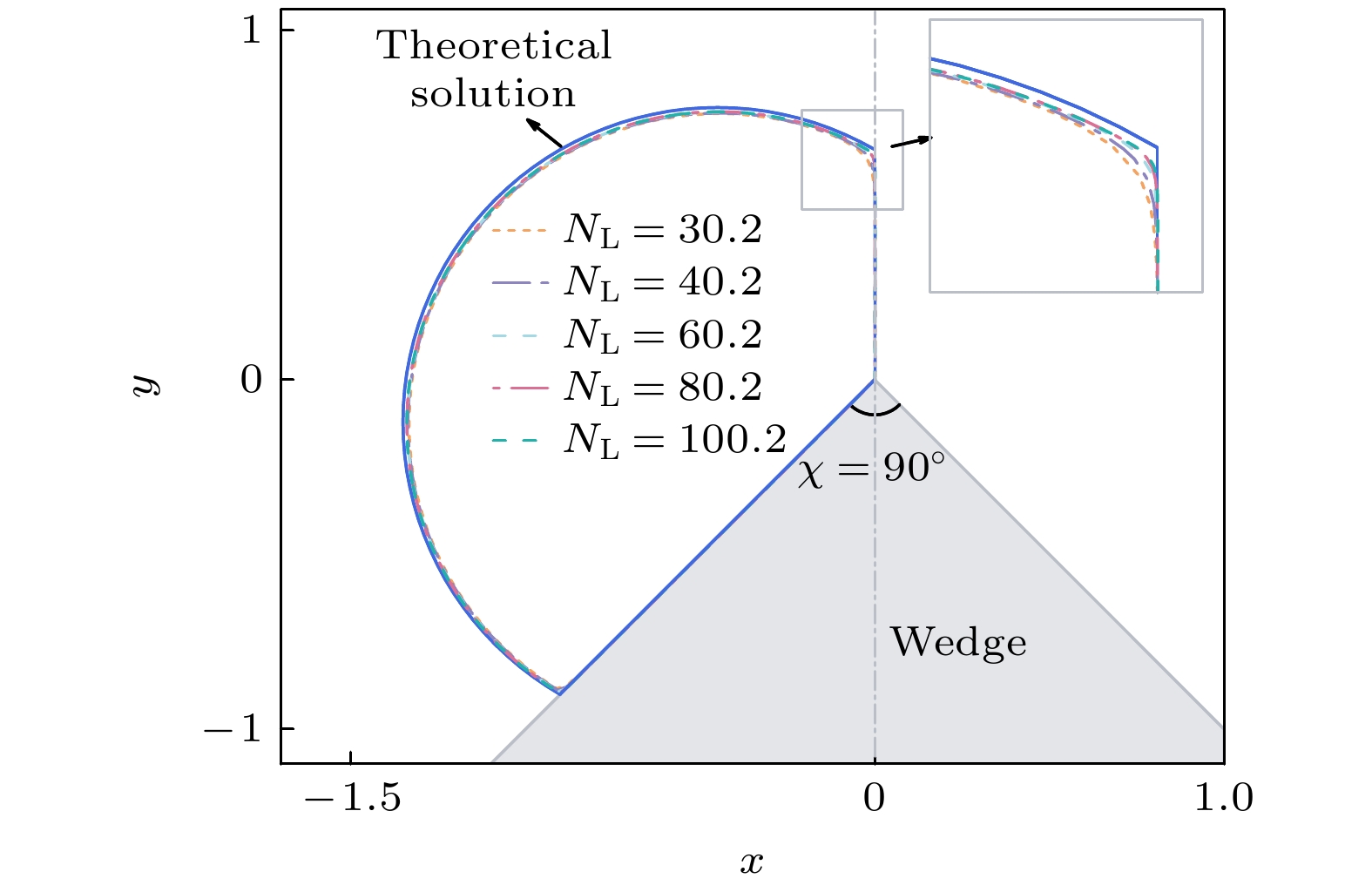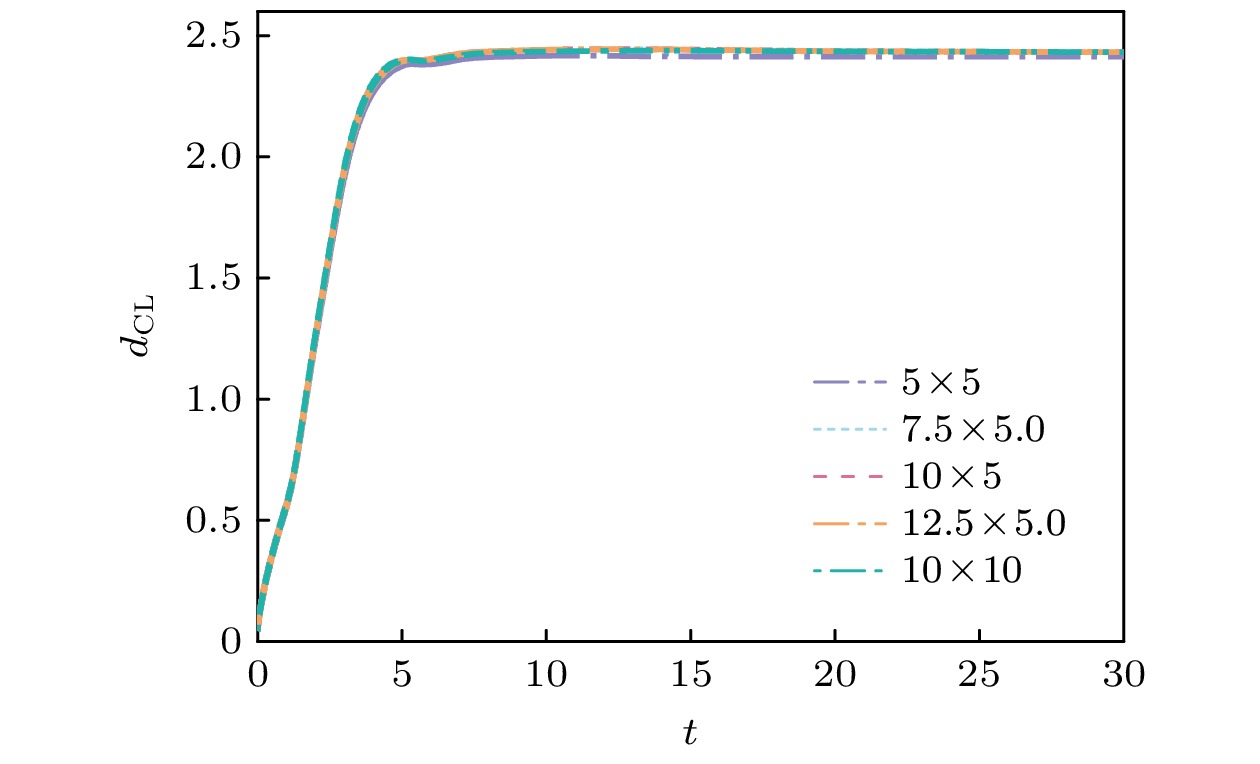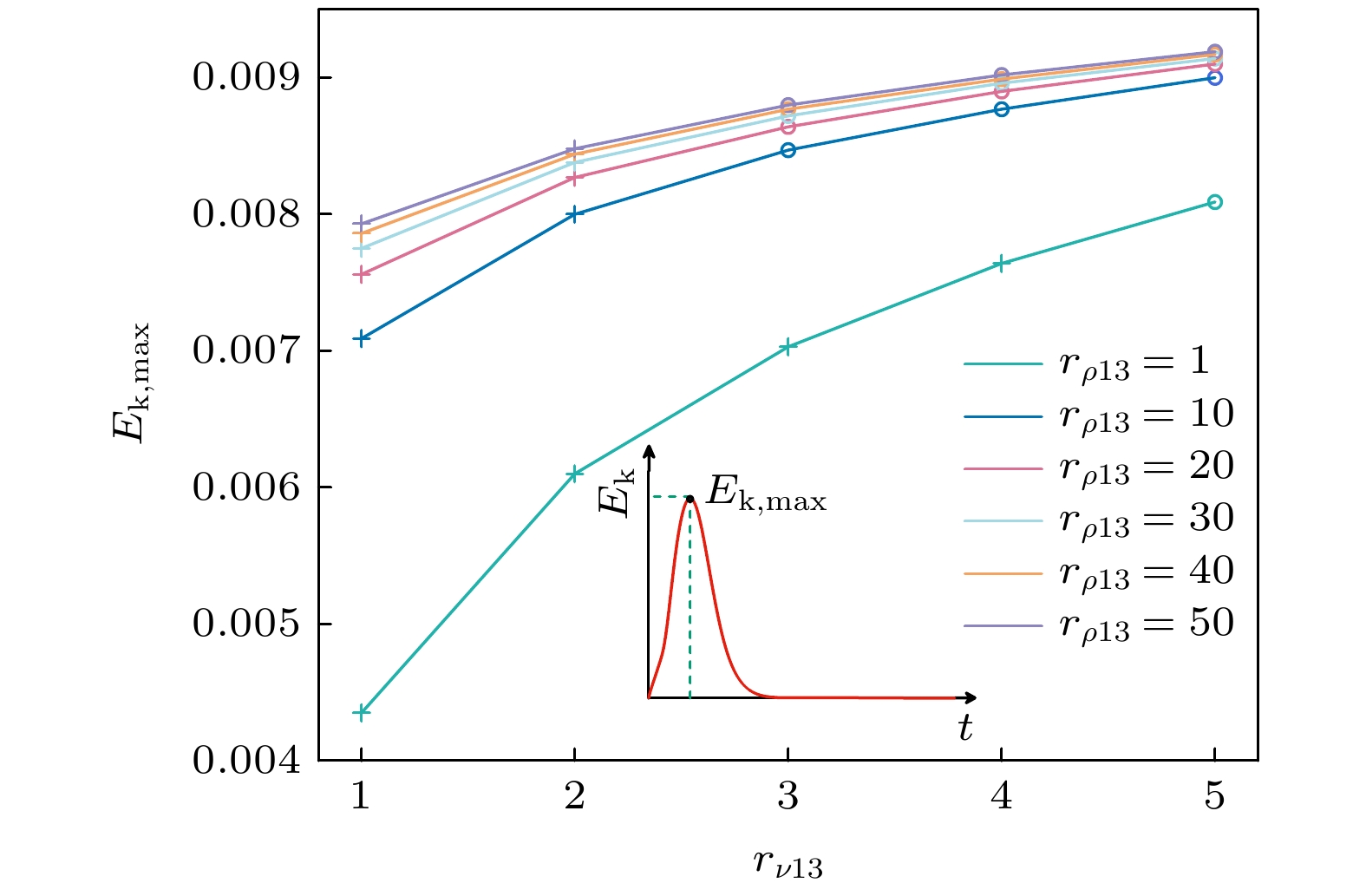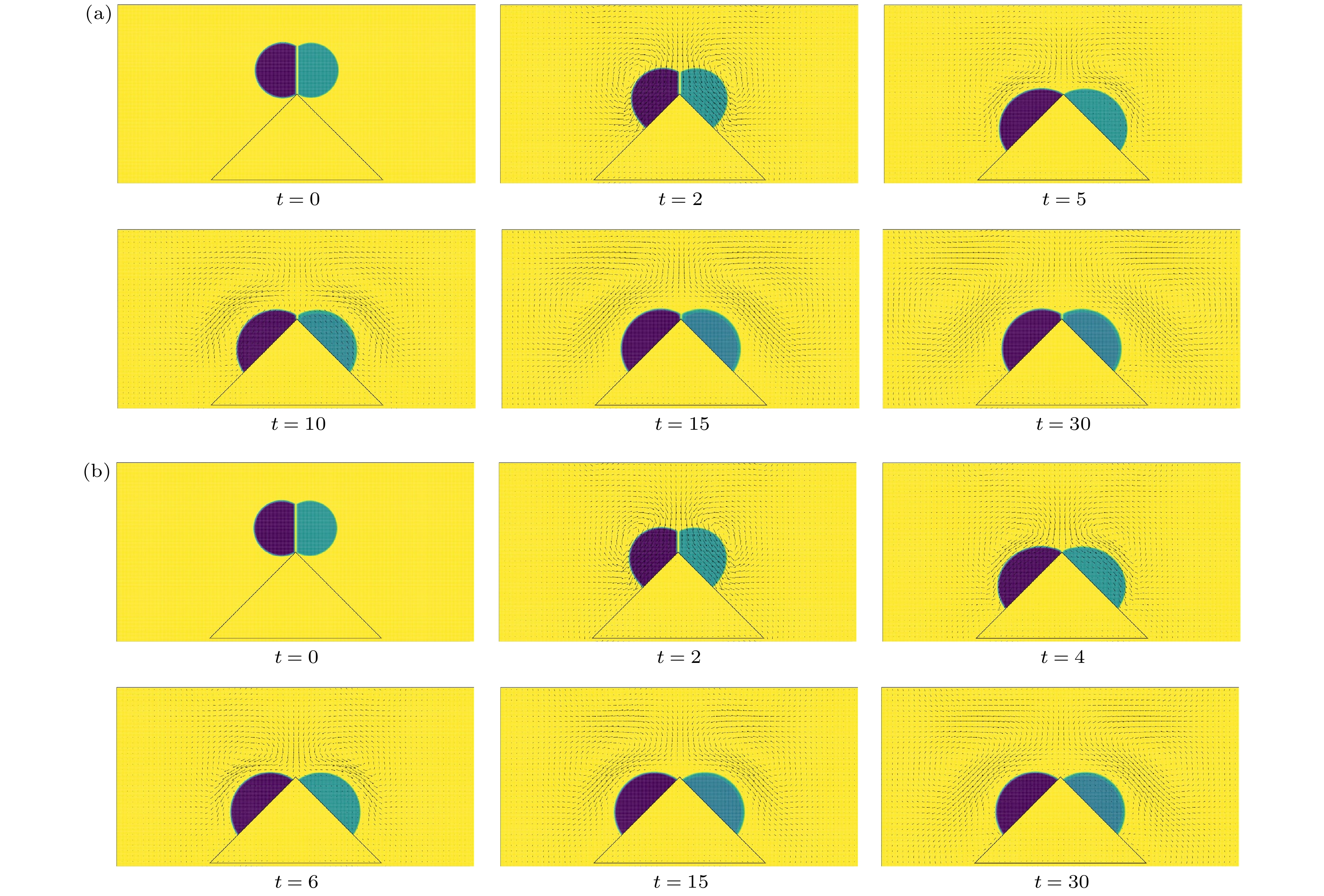-
固壁上液滴的润湿铺展行为是自然界中普遍存在的现象, 针对楔形体上的复合液滴, 采用基于相场理论的格子Boltzmann方法对其润湿铺展行为进行探究. 通过理论分析和数值模拟, 发现液滴润湿面积随接触角、楔形体顶角的减小而增大, 液滴也越容易分裂. 处于理论分裂临界状态附近的液滴, 在一定密度比、黏度比条件下将沿楔形体壁面分裂. 基于模拟结果生成以密度比、黏度比为坐标的液滴分裂状态相图, 比较发现相同条件下初始状态为平衡态的复合液滴更不易发生分裂. 另外模拟还表明非对称界面张力及非对称运动黏度比也是影响液滴分裂结果的重要因素.
-
关键词:
- 复合液滴 /
- 格子Boltzmann方法 /
- 润湿铺展 /
- 分裂
The wetting and spreading of droplets on solid walls are commonly seen in nature. The study of such a phenomenon can deepen our understanding of solid-liquid interaction and promote the development of relevant cutting-edge technological applications. In this work, the lattice Boltzmann method based on phase field theory is used to investigate the wetting and spreading of a compound droplet on a wedge. This method combines the finite-difference solution of the Cahn-Hilliard equations for ternary fluids to capture the interface dynamics and the lattice Boltzmann method for the hydrodynamics of the flow. Symmetric compound droplets with equal interfacial tensions on a wedge are considered first. Through theoretical analysis and numerical simulation, it is found that the wetted area on the wedge increases with the decrease of the contact angle of the wedge surface and the wedge apex angle. Depending on these two factors, the droplet may or may not split on the wedge. We also find that the droplet near the critical state predicted not to split by static equilibrium analysis could split during the spreading along the wall of the wedge under certain density and viscosity ratios. Based on the simulation results, a phase diagram of the droplet splitting state is generated with the density ratio and viscosity ratio as the coordinates. As the density ratio and kinematic viscosity ratio increase, the inertia effect becomes more prominent in the wetting and spreading process and the droplet is more likely to split. By comparing the phase diagrams in different initial conditions, it is found that under the same conditions, the compound droplet with an equilibrium initial state is less likely to split than that with an unequilibrium initial state, which is possibly because the initial total energy of the former is relatively small. Our study also shows that the kinematic viscosity ratio between the left half and the right half droplet may affect the results of droplet splitting. The increase of such a viscosity difference is conducive to the splitting of the compound droplet. Besides, asymmetric compound droplets with unequal interfacial tensions are also simulated, and it is found that the greater the wrapping degree between the left half and right half, the more difficult it is to separate the compound droplet.-
Keywords:
- compound droplet /
- lattice Boltzmann method /
- wetting and spreading /
- split
[1] Latthe S S, Sutar R S, Kodag V S, et al. 2019 Prog. Org. Coat. 128 52
 Google Scholar
Google Scholar
[2] Woerthmann B M, Totzauer L, Briesen H 2022 Powder Technol. 404 117443
 Google Scholar
Google Scholar
[3] Eres M H, Schwartz L W, Roy R V 2000 Phys. Fluids 12 1278
 Google Scholar
Google Scholar
[4] Dai Q W, Huang W, Wang X L, Khonsari M M 2021 Tribol. Int. 154 106749
 Google Scholar
Google Scholar
[5] Yang Y, Li X J, Zheng X, Chen Z Y, Zhou Q F, Chen Y 2018 Adv. Mater. 30 1704912
 Google Scholar
Google Scholar
[6] Young T 1805 Philos. Trans. R. Soc. London 95 65
[7] Sui T, Wang J D, Chen D R 2011 J. Colloid Interface Sci. 358 284
 Google Scholar
Google Scholar
[8] Li Y Q, Wu H A, Wang F C 2016 J. Phys. D Appl. Phys. 49 085304
 Google Scholar
Google Scholar
[9] Han Z Y, Duan L, Kang Q 2019 AIP Adv. 9 085203
 Google Scholar
Google Scholar
[10] Wang F, Schiller U D 2021 Soft Matter 17 5486
 Google Scholar
Google Scholar
[11] Herminghaus S, Brinkmann M, Seemann R 2008 Ann. Rev. Mater. Res. 38 101
 Google Scholar
Google Scholar
[12] Chang F M, Hong S J, Sheng Y J, Tsao H K 2010 J. Phys. Chem. C 114 1615
 Google Scholar
Google Scholar
[13] Zhou L M, Yang S M, Quan N N, et al. 2021 ACS Appl. Mater. Interfaces 13 55726
 Google Scholar
Google Scholar
[14] Ma B J, Shan L, Dogruoz B, Agonafer D 2019 Langmuir 35 12264
 Google Scholar
Google Scholar
[15] Courbin L, Bird J C, Reyssat M, Stone H A 2009 J. Phys. Condes. Matter 21 464127
 Google Scholar
Google Scholar
[16] Frank X, Perre P 2012 Phys. Fluids 24 042101
 Google Scholar
Google Scholar
[17] Lee Y, Matsushima N, Yada S, Nita S, Kodama T, Amberg G, Shiomi J 2019 Sci. Rep. 9 7787
 Google Scholar
Google Scholar
[18] Ben Said M, Selzer M, Nestler B, Braun D, Greiner C, Garcke H 2014 Langmuir 30 4033
 Google Scholar
Google Scholar
[19] Weyer F, Ben Said M, Hotzer J, Berghoff M, Dreesen L, Nestler B, Vandewalle N 2015 Langmuir 31 7799
 Google Scholar
Google Scholar
[20] Zhang C Y, Ding H, Gao P, Wu Y L 2016 J. Comput. Phys. 309 37
 Google Scholar
Google Scholar
[21] He Q, Li Y J, Huang W F, Hu Y, Wang Y M 2020 Phys. Rev. E 101 033307
 Google Scholar
Google Scholar
[22] Li S, Lu Y, Jiang F, Liu H H 2021 Phys. Rev. E 104 015310
 Google Scholar
Google Scholar
[23] Huang J J 2021 Phys. Fluids 33 072105
 Google Scholar
Google Scholar
[24] Chen S Y, Doolen G D 1998 Annu. Rev. Fluid Mech. 30 329
 Google Scholar
Google Scholar
[25] Jacqmin D 1999 J. Comput. Phys. 155 96
 Google Scholar
Google Scholar
[26] Huang J J, Wu J, Huang H B 2018 Eur. Phys. J. E 41 1
 Google Scholar
Google Scholar
[27] Liang H, Chai Z H, Shi B C, Guo Z L, Zhang T 2014 Phys. Rev. E 90 063311
 Google Scholar
Google Scholar
[28] Lee T 2009 Comput. Math. Appl. 58 987
 Google Scholar
Google Scholar
[29] Bouzidi M, Firdaouss M, Lallemand P 2001 Phys. Fluids 13 3452
 Google Scholar
Google Scholar
[30] Lallemand P, Luo L S 2000 Phys. Rev. E 61 6546
 Google Scholar
Google Scholar
[31] Guo Z L, Shi B C, Zheng C G 2011 Philos. Trans. R. Soc. A Math. Phys. Eng. Sci. 369 2283
 Google Scholar
Google Scholar
[32] Carlson A, Do-Quang M, Amberg G 2011 J. Fluid Mech. 682 213
 Google Scholar
Google Scholar
-
图 3 不同网格密度下液滴接触线位置的演化 (a)
$ {r_{{\rho _{13}}}} = $ $ {r_{{\nu _{13}}}} = 1 $ ; (b)$ {r_{{\rho _{13}}}} = {r_{{\nu _{13}}}} = 10 $ Fig. 3. Evolution of the contact line position of droplet under the different mesh densities: (a)
$ {r_{{\rho _{13}}}} = {r_{{\nu _{13}}}} = 1 $ ;(b)$ {r_{{\rho _{13}}}} = $ $ {r_{{\nu _{13}}}} = 10 $ .图 10 初始状态为非平衡态Janus状液滴的润湿铺展过程及速度场分布 (a)
$ {r_{{\rho _{13}}}} = 50 $ ,$ {r_{{\nu _{13}}}} = 1 $ ; (b)$ {r_{{\rho _{13}}}} = 50 $ ,$ {r_{{\nu _{13}}}} = 5 $ Fig. 10. Wetting and spreading process and velocity field distribution of Janus-like droplet with non-equilibrium initial state: (a)
$ {r_{{\rho _{13}}}} = 50 $ ,$ {r_{{\nu _{13}}}} = 1 $ ; (b)$ {r_{{\rho _{13}}}} = 50 $ ,$ {r_{{\nu _{13}}}} = 5 $ .图 13 初始状态为平衡态复合液滴的润湿铺展过程及速度场分布 (a)
$ {r_{{\rho _{13}}}} = 50 $ ,$ {r_{{\nu _{13}}}} = 5 $ ; (b)$ {r_{{\rho _{13}}}} = 50 $ ,$ {r_{{\nu _{13}}}} = 10 $ Fig. 13. Wetting and spreading process and velocity field distribution of compound droplet with equilibrium initial state: (a)
$ {r_{{\rho _{13}}}} = 50 $ ,$ {r_{{\nu _{13}}}} = 5 $ ; (b)$ {r_{{\rho _{13}}}} = 50 $ ,$ {r_{{\nu _{13}}}} = 10 $ . -
[1] Latthe S S, Sutar R S, Kodag V S, et al. 2019 Prog. Org. Coat. 128 52
 Google Scholar
Google Scholar
[2] Woerthmann B M, Totzauer L, Briesen H 2022 Powder Technol. 404 117443
 Google Scholar
Google Scholar
[3] Eres M H, Schwartz L W, Roy R V 2000 Phys. Fluids 12 1278
 Google Scholar
Google Scholar
[4] Dai Q W, Huang W, Wang X L, Khonsari M M 2021 Tribol. Int. 154 106749
 Google Scholar
Google Scholar
[5] Yang Y, Li X J, Zheng X, Chen Z Y, Zhou Q F, Chen Y 2018 Adv. Mater. 30 1704912
 Google Scholar
Google Scholar
[6] Young T 1805 Philos. Trans. R. Soc. London 95 65
[7] Sui T, Wang J D, Chen D R 2011 J. Colloid Interface Sci. 358 284
 Google Scholar
Google Scholar
[8] Li Y Q, Wu H A, Wang F C 2016 J. Phys. D Appl. Phys. 49 085304
 Google Scholar
Google Scholar
[9] Han Z Y, Duan L, Kang Q 2019 AIP Adv. 9 085203
 Google Scholar
Google Scholar
[10] Wang F, Schiller U D 2021 Soft Matter 17 5486
 Google Scholar
Google Scholar
[11] Herminghaus S, Brinkmann M, Seemann R 2008 Ann. Rev. Mater. Res. 38 101
 Google Scholar
Google Scholar
[12] Chang F M, Hong S J, Sheng Y J, Tsao H K 2010 J. Phys. Chem. C 114 1615
 Google Scholar
Google Scholar
[13] Zhou L M, Yang S M, Quan N N, et al. 2021 ACS Appl. Mater. Interfaces 13 55726
 Google Scholar
Google Scholar
[14] Ma B J, Shan L, Dogruoz B, Agonafer D 2019 Langmuir 35 12264
 Google Scholar
Google Scholar
[15] Courbin L, Bird J C, Reyssat M, Stone H A 2009 J. Phys. Condes. Matter 21 464127
 Google Scholar
Google Scholar
[16] Frank X, Perre P 2012 Phys. Fluids 24 042101
 Google Scholar
Google Scholar
[17] Lee Y, Matsushima N, Yada S, Nita S, Kodama T, Amberg G, Shiomi J 2019 Sci. Rep. 9 7787
 Google Scholar
Google Scholar
[18] Ben Said M, Selzer M, Nestler B, Braun D, Greiner C, Garcke H 2014 Langmuir 30 4033
 Google Scholar
Google Scholar
[19] Weyer F, Ben Said M, Hotzer J, Berghoff M, Dreesen L, Nestler B, Vandewalle N 2015 Langmuir 31 7799
 Google Scholar
Google Scholar
[20] Zhang C Y, Ding H, Gao P, Wu Y L 2016 J. Comput. Phys. 309 37
 Google Scholar
Google Scholar
[21] He Q, Li Y J, Huang W F, Hu Y, Wang Y M 2020 Phys. Rev. E 101 033307
 Google Scholar
Google Scholar
[22] Li S, Lu Y, Jiang F, Liu H H 2021 Phys. Rev. E 104 015310
 Google Scholar
Google Scholar
[23] Huang J J 2021 Phys. Fluids 33 072105
 Google Scholar
Google Scholar
[24] Chen S Y, Doolen G D 1998 Annu. Rev. Fluid Mech. 30 329
 Google Scholar
Google Scholar
[25] Jacqmin D 1999 J. Comput. Phys. 155 96
 Google Scholar
Google Scholar
[26] Huang J J, Wu J, Huang H B 2018 Eur. Phys. J. E 41 1
 Google Scholar
Google Scholar
[27] Liang H, Chai Z H, Shi B C, Guo Z L, Zhang T 2014 Phys. Rev. E 90 063311
 Google Scholar
Google Scholar
[28] Lee T 2009 Comput. Math. Appl. 58 987
 Google Scholar
Google Scholar
[29] Bouzidi M, Firdaouss M, Lallemand P 2001 Phys. Fluids 13 3452
 Google Scholar
Google Scholar
[30] Lallemand P, Luo L S 2000 Phys. Rev. E 61 6546
 Google Scholar
Google Scholar
[31] Guo Z L, Shi B C, Zheng C G 2011 Philos. Trans. R. Soc. A Math. Phys. Eng. Sci. 369 2283
 Google Scholar
Google Scholar
[32] Carlson A, Do-Quang M, Amberg G 2011 J. Fluid Mech. 682 213
 Google Scholar
Google Scholar
计量
- 文章访问数: 4991
- PDF下载量: 68
- 被引次数: 0
















 下载:
下载:









































